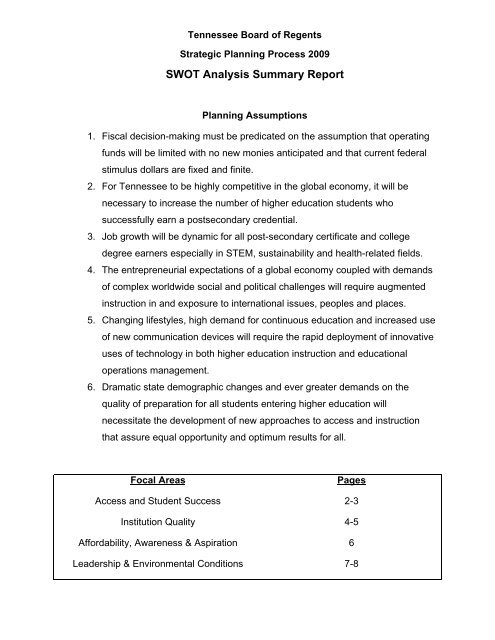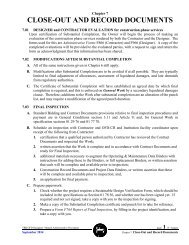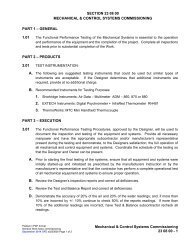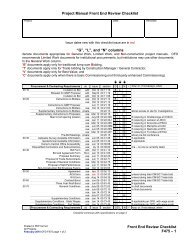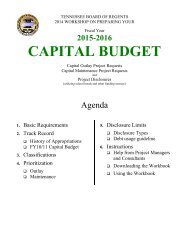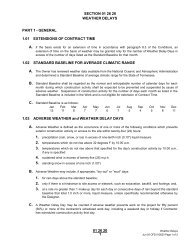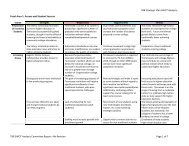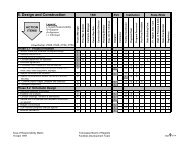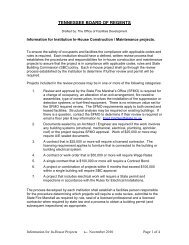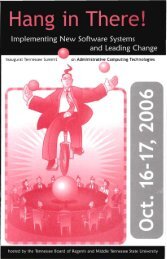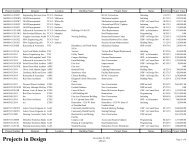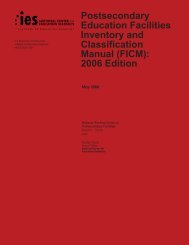SWOT Analysis Summary Report - Strategic Planning - Tennessee ...
SWOT Analysis Summary Report - Strategic Planning - Tennessee ...
SWOT Analysis Summary Report - Strategic Planning - Tennessee ...
Create successful ePaper yourself
Turn your PDF publications into a flip-book with our unique Google optimized e-Paper software.
<strong>Tennessee</strong> Board of Regents<br />
<strong>Strategic</strong> <strong>Planning</strong> Process 2009<br />
<strong>SWOT</strong> <strong>Analysis</strong> <strong>Summary</strong> <strong>Report</strong><br />
<strong>Planning</strong> Assumptions<br />
1. Fiscal decision-making must be predicated on the assumption that operating<br />
funds will be limited with no new monies anticipated and that current federal<br />
stimulus dollars are fixed and finite.<br />
2. For <strong>Tennessee</strong> to be highly competitive in the global economy, it will be<br />
necessary to increase the number of higher education students who<br />
successfully earn a postsecondary credential.<br />
3. Job growth will be dynamic for all post-secondary certificate and college<br />
degree earners especially in STEM, sustainability and health-related fields.<br />
4. The entrepreneurial expectations of a global economy coupled with demands<br />
of complex worldwide social and political challenges will require augmented<br />
instruction in and exposure to international issues, peoples and places.<br />
5. Changing lifestyles, high demand for continuous education and increased use<br />
of new communication devices will require the rapid deployment of innovative<br />
uses of technology in both higher education instruction and educational<br />
operations management.<br />
6. Dramatic state demographic changes and ever greater demands on the<br />
quality of preparation for all students entering higher education will<br />
necessitate the development of new approaches to access and instruction<br />
that assure equal opportunity and optimum results for all.<br />
Focal Areas<br />
Pages<br />
Access and Student Success 2-3<br />
Institution Quality 4-5<br />
Affordability, Awareness & Aspiration 6<br />
Leadership & Environmental Conditions 7-8
Page 2 of 9<br />
TBR <strong>SWOT</strong> <strong>Analysis</strong> <strong>Summary</strong> <strong>Report</strong>…
TBR <strong>SWOT</strong> <strong>Analysis</strong> <strong>Summary</strong> <strong>Report</strong>…<br />
Focal Area 1: Access and Student Success<br />
Theme 1: Preparation of Incoming Students<br />
Strength: Higher standards for high school diplomas plus <strong>Tennessee</strong>’s merit<br />
based scholarship system provide opportunity and incentive for students to<br />
remain in <strong>Tennessee</strong> for higher education.<br />
Weakness: Because a large portion of students entering our institutions do<br />
not have an adequate preparation to attend college, they have a low chance<br />
of success and must take remedial and developmental courses before<br />
beginning a college track.<br />
Opportunity: Our institutions can work with <strong>Tennessee</strong> high schools, where<br />
graduation rates have increased markedly, to ensure that graduation<br />
requirements align with freshmen level coursework through P-16 agreements<br />
and initiatives like the American Diploma Project. Additionally, agreements<br />
for dual-credit and dual-enrollment may alleviate the transition process for<br />
many students.<br />
Threat: Our institutions rely heavily on adult students who will be unaffected<br />
by improvements to high school graduation requirements. Furthermore,<br />
future enrollment gains are expected to come from previously underserved<br />
populations that historically are less prepared for college.<br />
Theme 2: Increasing Access<br />
Strength: The <strong>Tennessee</strong> Board of Regents offers multiple points of entry to<br />
higher education including universities, community colleges, and technology<br />
centers. In addition, the Regents Online Campus Collaborative (ROCC) and<br />
campus-based distance education programs offer an additional delivery<br />
method for access to higher education.<br />
Weakness: Enrollment growth will continue to rely on traditionally<br />
underserved and adult populations. These students often have greater<br />
barriers to access and success than traditional students, such as family and<br />
work constraints, which are not always fully addressed by TBR institutions.<br />
Opportunity: New technologies, like social networking, will make it easier to<br />
recruit, advise and engage students who might otherwise not be reached by<br />
traditional marketing strategies.<br />
Threat: The low percentage of Tennessean’s with a postsecondary credential<br />
contributes to an environment that undervalues the need for higher education.<br />
Also, decreasing enrollment of male students threatens future opportunities<br />
for growth.<br />
Page 3 of 9
TBR <strong>SWOT</strong> <strong>Analysis</strong> <strong>Summary</strong> <strong>Report</strong>…<br />
Theme 3: Retention Initiatives<br />
Strength: TBR campuses have implemented a variety of initiatives such as<br />
first-year seminars, orientation programs, co-curricular activities and campus<br />
sponsored events to help increase the freshmen year retention and help all<br />
students stay engaged.<br />
Weakness: The production of degrees by TBR institutions falls below the<br />
United States and Southern Regional Education Board (SREB) average.<br />
Many campuses still do not have a fully integrated plan for student retention<br />
and persistence to degree attainment.<br />
Opportunity: Institutions have the opportunity to increase student<br />
engagement by reaching out to the surrounding community, utilizing new<br />
technologies, publicizing study abroad opportunities, expanding internship<br />
opportunities, and enhancing students’ roles in research with faculty.<br />
Threats: State appropriations for higher education are not expected to<br />
improve. Thus, time and resource intensive initiatives including student life<br />
events that foster student engagement will be threatened as campus budgets<br />
become more constrained.<br />
Theme 4: Technology<br />
Strength: The Board of Regents online learning initiatives both through<br />
ROCC and campus-specific programs and courses are well established and<br />
have had considerable enrollment growth. Many initiatives have been<br />
implemented at the campuses to better integrate technology into the<br />
classroom, and new technology such as the Banner system has improved<br />
collection and reporting of student data at the campus and state-wide levels.<br />
Weakness: Technology centers, community colleges, and universities all<br />
have different information and educational technology needs, and many of<br />
their infrastructures are not currently equipped to handle the demands of such<br />
new technologies as high definition interactive broadcasts.<br />
Opportunity: Emerging technologies could improve and enhance teaching<br />
and learning as well as facilitate reaching even more distance education<br />
students as well as reduce costs especially for the ROCC.<br />
Threat: Large gaps exist in the availability of technology to different parts of<br />
the state, and many populations may not have access to online learning,<br />
campus websites or eLearning opportunities. Furthermore, falling behind<br />
other systems or proprietary schools in the use of technology could put the<br />
system at a competitive disadvantage for future enrollment.<br />
Page 4 of 9
TBR <strong>SWOT</strong> <strong>Analysis</strong> <strong>Summary</strong> <strong>Report</strong>…<br />
Focal Area 2: Institution Quality<br />
Theme 1: Faculty and Staff Quality<br />
Strength: All faculty meet expectations for institutional re-accreditation by the<br />
Southern Association for Colleges and Schools (SACS) and are encouraged<br />
to take advantage of professional development opportunities that further<br />
enhance their teaching and research credentials.<br />
Weakness: Because faculty and staff salaries remain below SREB and<br />
United States averages at both universities and community colleges,<br />
attracting and retaining quality personnel is difficult. The scope of professional<br />
development opportunities may be jeopardized by budgetary restrictions,<br />
which will make it increasingly difficult to assure the quality of ongoing<br />
training.<br />
Opportunity: Economic difficulty in other states makes this an excellent time<br />
to hire highly qualified faculty and staff that might be out of work. Further<br />
development of system-wide faculty training opportunities may provide faculty<br />
enrichment in a cost effective manner.<br />
Threat: A reduction in state appropriations has caused campuses and the<br />
system office to lose many highly trained employees to buyouts. Reductions<br />
are expected to continue to eliminate faculty and staff and thus threaten<br />
buying power for new faculty, quality of instruction and scope of student<br />
services even as enrollment increases.<br />
Theme 2: Scholarly and Creative Activity<br />
Strength: Research performed by TBR institutions and creative arts<br />
programs provided at TBR campuses add prestige to the system, provide<br />
meaningful student learning experiences, and enhance the quality of life for<br />
our citizenry.<br />
Weakness: Many departments lack sufficient facilities, equipment and<br />
technology for research or have facilities that are subpar by current<br />
standards. Faculty with strong research programs are likely to be lured away<br />
by institutions with better facilities and higher salaries.<br />
Opportunity: Federal funds in support of environmental concerns will provide<br />
opportunities for research partnerships. Licensing of intellectual property is<br />
another opportunity. Also, <strong>Tennessee</strong>’s strong ties to the music industry could<br />
provide growing support for creative activity on campuses.<br />
Threat: TBR institutions could lose large grants if researchers do not have<br />
ample support, and gubernatorial support is focused on only a few campuses.<br />
Funding for creative activities in the music and arts are threatened at every<br />
level of education due to financial hardships.<br />
Page 5 of 9
TBR <strong>SWOT</strong> <strong>Analysis</strong> <strong>Summary</strong> <strong>Report</strong>…<br />
Theme 3: Academic Program Quality<br />
Strength: Academic program quality is monitored by accreditation, program<br />
review, academic audit, and performance funding requirements. Programs<br />
with standardized licensure exams are competitive with national averages.<br />
Also, established and newly developed articulation agreements including dual<br />
admissions agreements help students move from technology centers to<br />
community colleges to universities.<br />
Weakness: Graduation rates are insufficient to sustain some programs.<br />
Some programs do not have established methods for ensuring rigor and<br />
validity with regards to ever-changing expectations of the job market.<br />
Furthermore, campus infrastructure is aging and upgrades to facilities for<br />
student learning and research are needed to continuously improve academic<br />
programs.<br />
Opportunity: Pilot programs in such areas as developmental studies, e-<br />
learning, and the Teaching Quality Initiative are developing ways to improve<br />
program outcomes while making the college experience more valuable and<br />
more economically viable for students. New software makes it possible to<br />
better track student outcomes and provide feedback to academic programs.<br />
Threat: If not consistently aligned with the mission of each institution,<br />
enrollment growth, outside monitoring, and industry partnerships may<br />
threaten institutional identity. A continued need for remediation could<br />
threaten the rigor of some programs.<br />
Page 6 of 9
TBR <strong>SWOT</strong> <strong>Analysis</strong> <strong>Summary</strong> <strong>Report</strong>…<br />
Focal Area 3: Affordability, Awareness, and Aspiration<br />
Theme 1: Cost of Attending College<br />
Strength: Tuition and fees in <strong>Tennessee</strong> are below the US average, and<br />
technology centers and community colleges offer affordable opportunities.<br />
The availability of the HOPE scholarships and Wilder Naifeh grants provide<br />
financial aid at all levels. Campuses are implementing new initiatives such as<br />
textbook policies to lower costs for students<br />
Weakness: The cost of tuition, textbooks, ROCC courses and other costs<br />
associated with college attendance are progressively rising above the SREB<br />
average and shifting to the student. Need-based scholarships and<br />
scholarships for adult students are limited.<br />
Opportunity: TBR could partner with the state Board of Education, P-16<br />
Councils, the Voluntary System of Accountability and others to enhance the<br />
public’s understanding of higher education costs. Discussing costs and<br />
financial aid options as early as middle school and implementing reliable cost<br />
estimators for attending TBR institutions would help future students plan<br />
ahead for college.<br />
Threat: Potential students may opt out of higher education entirely if rising<br />
higher education costs are not explained or supported by adequate advice on<br />
family financial planning. State and federal financial aid might not be able to<br />
keep pace with rising tuition and other costs.<br />
Theme 2: Resourcefulness<br />
Strength: Institutions have successfully increased private donations and<br />
research funding over the last five years. Collaborative activities such as<br />
ROCC and agreements among TBR campus libraries help to eliminate the<br />
duplication of resources by campuses.<br />
Weakness: There is an under-utilization of grant opportunities due to time<br />
and staff constraints as well as limited availability of matching funds. Also, in<br />
some cases, courses have similar content but are duplicated because of<br />
program affiliation.<br />
Opportunity: An increased investment up-front in fund raising and grant<br />
writing could potentially show strong returns. The Board could implement<br />
workshops to educate faculty and staff how to apply for grants or raise funds.<br />
Threat: An economic slowdown could reduce levels of private donations as<br />
well as diminish grant opportunities from both public and private sources.<br />
Page 7 of 9
TBR <strong>SWOT</strong> <strong>Analysis</strong> <strong>Summary</strong> <strong>Report</strong>…<br />
Focal Area 4: Leadership and Environmental Conditions<br />
Theme 1: Leadership and Governance<br />
Strength: Institution leaders are well respected and highly engaged in their<br />
respective communities, which enhances community life and also adds<br />
regard for the institution. The structure of TBR allows for close interaction<br />
between leadership of technology centers, community colleges, and<br />
universities that facilitates articulation agreements and other collaborative<br />
activities.<br />
Weakness: There is a lack of benchmarking data regarding the operational<br />
costs of state higher education governance systems. Efforts to increase<br />
institution accountability have led to increased bureaucracy and reporting<br />
requirements.<br />
Opportunities: Campus leaders can continue to use their high-profile<br />
positions to bring in new community partnerships. Restructuring the state<br />
system for governance of higher education could better align goals and<br />
priorities leading to a more streamlined educational system.<br />
Threat: Over-commercializing campuses through partnerships could lead to<br />
the loss of independent and unbiased teaching and research. Restructuring<br />
the state system for governance of higher education would require buy-in at<br />
all levels, which may not be present and could lead to unrest at the<br />
institutions.<br />
Theme 2: Economic Leadership<br />
Strength: TBR institutions are adept at fulfilling the changing needs of the<br />
workforce by providing immediate training for a new career, especially the<br />
technology centers, community colleges and Regents Online Continuing<br />
Education (ROCE). Furthermore, the technology centers and community<br />
colleges emphasize job placement for their graduates and demonstrate a<br />
history of success.<br />
Weakness: Resources to hire faculty who are qualified to teach and train<br />
students in new careers produced by the changing economy are restricted.<br />
Partnerships between industry and TBR institutions to train employees for<br />
existing jobs are limited or isolated to particular regions, and resources to<br />
support non-credit workforce development are limited. Institutions may not<br />
have sufficient capacity or flexibility to handle sudden enrollment spikes or<br />
declines.<br />
Opportunity: All institutions have the opportunity to train students to fill<br />
shortages in STEM related fields. By partnering with industry, federal<br />
government, and the department of education, institutions could create new<br />
programs and gain funding for endowed faculty to fill shortages.<br />
Page 8 of 9
TBR <strong>SWOT</strong> <strong>Analysis</strong> <strong>Summary</strong> <strong>Report</strong>…<br />
Threat: There is a lack of a clear vision at the state government of what role<br />
public higher education plays in attracting new jobs to <strong>Tennessee</strong>, therefore<br />
opportunities to attract new business and industry may be lost to other states.<br />
Theme 3: Competitive Environment<br />
Strength: TBR institutions provide a wide spectrum of attractive options to<br />
people seeking advanced education including out-of-state students from a<br />
certificate to professional and terminal degrees that directly support growth<br />
and development of the <strong>Tennessee</strong> workforce.<br />
Weakness: Inability to produce sufficient numbers of students who earn a<br />
postsecondary credential may hamper growth of existing businesses as well<br />
as the ability to attract new high paying industries to <strong>Tennessee</strong>.<br />
Opportunity: TBR could market to <strong>Tennessee</strong>’s growing Hispanic and other<br />
minority populations as well as to the large number of adults without degrees.<br />
Additionally, the state’s low tax rates for industry could bring new training<br />
opportunities for all TBR institutions.<br />
Threat: Even as tuition rises, per FTE funding at TBR institutions is in the<br />
lower range compared to other SREB states. As the state’s population is<br />
growing disproportionately from one area to the next, some institutions may<br />
see rapid growth in enrollment while others see little change or declining<br />
enrollment. Growth in proprietary schools could also adversely affect<br />
enrollment dynamics.<br />
Page 9 of 9


